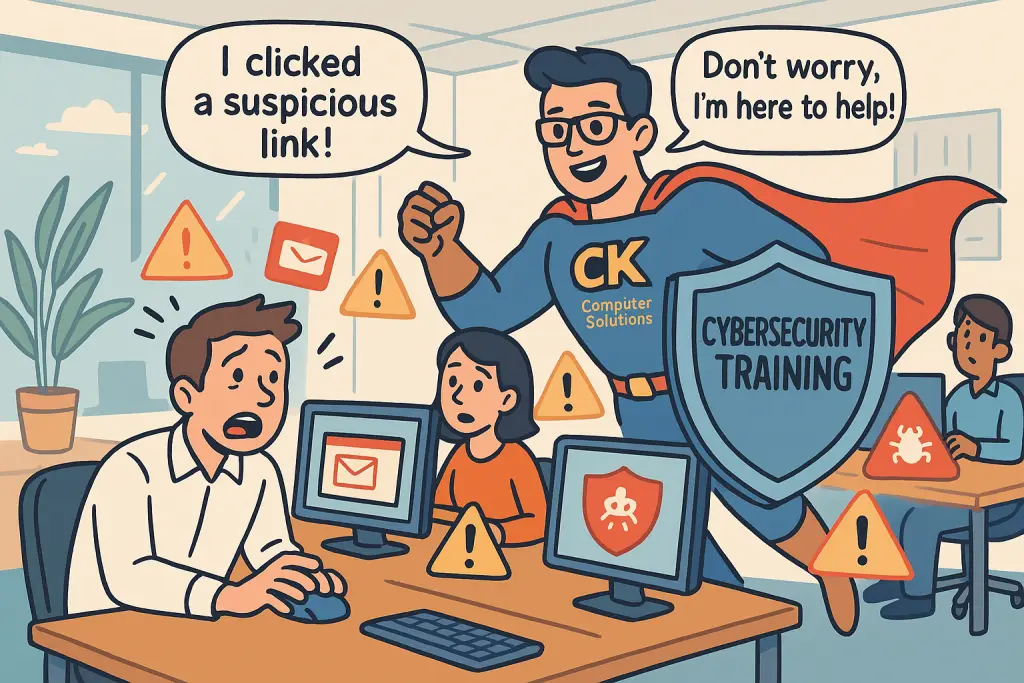
1. Start with a Baseline Simulation
Before launching any custom campaigns, it’s smart to begin with a baseline simulation. This provides a clear, honest view of your organisation’s current exposure to phishing threats.
It helps you identify which users are most likely to click malicious links, who might give away credentials, and who reports suspicious content as they should. That initial data becomes the benchmark for future training and gives you a solid foundation to build on.
Choose a realistic phishing template that mirrors something your team might see in their inbox, such as a Microsoft sign-in page or a delivery notification. These templates create a believable scenario, helping you measure responses in a real-world context.
2. Target by Department or Role
A blanket approach to phishing simulation rarely hits the mark. Different departments face different types of threats—what tricks an HR manager might fall for won’t necessarily fool someone in finance.
Tailor simulations to specific roles or teams. For instance, the finance department could receive an email mimicking a supplier invoice. Meanwhile, HR might get a phoney job application with a dodgy attachment. These targeted campaigns improve relevance and allow staff to train against the threats they’re most likely to encounter.
Not only does this increase the effectiveness of the simulation, but it also makes your employees feel like the training is actually applicable to their role—something they’ll take more seriously.
3. Monitor Performance and Spot Trends
One of the strongest features in Microsoft 365’s security suite is the depth of its reporting. You can track who clicked, who entered credentials, who reported the simulation, and how quickly they responded.
This data tells a powerful story. Are certain users repeatedly falling for phishing attempts? Are some departments more vigilant than others? These trends can help you deliver more targeted follow-up training and better allocate resources where they’re most needed.
To stay ahead of the curve, enable automated alerts or schedule regular performance summaries. The quicker you can react to a problem area, the more effective your interventions will be.
4. Deliver Instant Training After a Mistake
When someone clicks a simulated phishing email, make sure the training follows immediately. Redirect them to a short training module on the spot. When the lesson comes right after the mistake, it tends to stick better.
This isn’t about shaming anyone—it’s about creating a learning opportunity at the most teachable moment. People are much more open to understanding what went wrong when it’s fresh in their minds.
Keep the training sharp and scenario-based. Short, snappy content works better than long, passive slideshows or videos. The goal is to inform, not to bore or overwhelm.
5. Make It a Continuous Process
Cybersecurity training can’t be treated as a one-off event. The threat landscape changes constantly, and attackers are always coming up with new tactics. Your training needs to evolve with them.
Schedule phishing simulations regularly—monthly or quarterly. And always mix it up. Use different email types, target various departments, and rotate through tactics like link-based attacks, file attachments, and credential harvesting.
Routine training keeps awareness high and reduces the chance that your staff will get complacent. The more exposure they have to a variety of threats, the more confident and prepared they’ll be.
6. Reinforce Your Internal Security Policies
Simulated phishing should mirror your real-life security protocols. There’s no point training someone to recognise a suspicious email if you haven’t also shown them the correct steps to take once they do.
Tie the simulations directly into your organisation’s policies. For example, if your policy says not to forward suspect emails, build that into the training. If you have a reporting channel, make sure staff know exactly how to use it during the exercise.
This is a great opportunity to reinforce internal processes—whether that’s escalation procedures, who to contact after clicking something dodgy, or how to report a breach. The simulation becomes both training and policy reminder in one.
How CK Computer Solutions Can Help
At CK Computer Solutions – Managed IT Services Dublin, we don’t just hand you the tools—we help you use them to full effect. As your trusted Managed Service Provider, we can help integrate and manage Microsoft Defender for Office 365 across your organisation.
Our team can:
-
Roll out tailored phishing simulations that suit your team’s structure.
-
Monitor reports and help interpret the results.
-
Provide on-the-spot training content to match your internal policies.
-
Offer ongoing support and improvements to your security training programme.
With CK Computer Solutions in your corner, you’ll turn your staff into a knowledgeable, responsive defence layer—and that’s priceless in today’s threat environment. Let’s work together to make sure your people are ready for anything.

